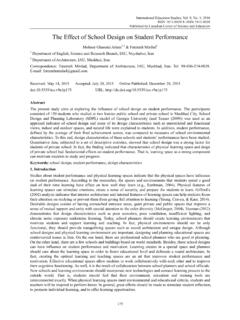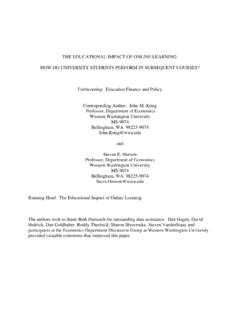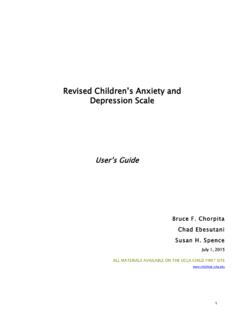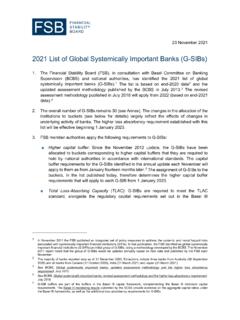Transcription of Rate the Raters 2020 Report
1 Introduction | Rate the Raters 2020 | 1 Rate the Raters 2020:Investor Survey and Interview ResultsMarch 2020 Introduction | Rate the Raters 2020 | 2 About this ReportSustainAbility, an ERM Group company, is a think tank and advisory firm that works to inspire and enable business to lead the way to a sustainable economy. Our agenda-shaping research challenges individuals, companies and industries to transform the ways they think and do business, and explains how to make lasting change. All SustainAbility research reports are publicly available at the Raters Research Series In 2010, SustainAbility undertook its first Rate the Raters project to better understand the environmental, social, and governance (ESG) ratings landscape and provide perspectives to help companies, investors and other stakeholders make sense of and derive more value from ESG ratings. In 2017, SustainAbility revisited this topic in order to provide an updated view of stakeholder perspectives and shed light on how ESG ratings were being used, as well as to identify challenges and provide recommendations.
2 Rate the Raters 2018: Ratings Revisited outlined themes that emerged from several roundtables and interviews with investors, companies and ratings research firms and explored why the topic merited new research. These roundtables informed the work conducted in 2019-2020 that culminates with this the Raters 2019 2020 The first Report , Rate the Raters 2019: Expert Survey Results, focused on key insights from a survey of over 300 sustainability professionals in corporate, NGO, government, academic and other sectors. Phase two, this Report , was designed to highlight the perspectives of investors. It shares insights from 17 in-depth interviews with investors, supplemented by a survey of 25 investors, highlighting their views on current ESG ratings and how they use these ratings to evaluate ESG topics. The Report also includes specific recommendations for companies on how to approach the ESG ratings landscape in order to meet investor needs.
3 We hope that this research will spur further dialogue between investors, corporations and ESG research/rating firms to improve the ESG ecosystem for all stakeholders. We welcome your feedback and suggestions. Rate the Raters 2020 | 2 Introduction | Rate the Raters 2020 | 3 AcknowledgementsWe express sincere thanks to our sponsors for their generous support; our interviewees and survey respondents; GlobeScan for distributing the survey; and, all of our SustainAbility, BrownFlynn, and other ERM Group colleagues and peers who generously contributed their time and insights to this Christina Wong Erika PetroyContributorsAiste BrackleyMark LeeOur Sponsors Rate the Raters 2020 | 3 Introduction | Rate the Raters 2020 | 4 ContentsIntroductionObjectives and MethodologyKey FindingsInvestor InsightsTop Sources of ESG InformationESG Ratings Use FrequencyNumber of ESG Ratings UsedESG Ratings SelectionHow Investors Use ESG RatingsInvestor Critiques of ESG RatingsInvestor Perceptions of Specific ESG RatingsInvestor Future Views and ExpectationsFinal Recommendations for Companies Conclusion Appendix 050812161718191922283341464850 Rate the Raters 2020 | 4 Introduction | Rate the Raters 2020 | 5 Introduction Rate the Raters 2020 | 5 Introduction | Rate the Raters 2020 | 6A decade of ratings.
4 Growth and evolution Since our original Rate the Raters research series launched in 2010 and concluded in 2013, the size, influence and complexity of the ESG ecosystem have all increased significantly. The number of ESG standards and frameworks, data providers, ratings and rankings has expanded, with 600+ ESG ratings and rankings existing globally as of 2018 and continuing to grow since. As this system has developed, it has influenced how companies Report on and disclose ESG data and performance, shaped the creation of ESG-related investment products, and framed the public perception of companies. During this period, complexity has increased, as more traditional investment data providers, credit rating agencies and others have entered the ratings marketplace, driving merger and acquisition activity. Recent examples of this dynamism include Moody s acquisition of a majority stake in Vigeo Eiris as well as S&P Global s purchase of the ESG business of RobecoSAM , including its well-known Corporate Sustainability Assessment (CSA), which underpins the Dow Jones Sustainability of ratings field dynamism The rapid expansion of the ESG ecosystem has been driven in part by increased corporate reporting, which has generated reams of new and better ESG data.
5 From 2011 to 2018, the proportion of S&P 500 companies reporting on their sustainability efforts, corporate social responsibility activities, and ESG performance increased from just under 20% to 86% . At the same time, investors have been exploring pathways for ESG integration, reactively looking to better understand corporate ESG performance in order to better respond to client pressure, and proactively seeking means to apply ESG in ways that might improve investment decisions. Indicative of this growth, the more than 2,300 signatories to the UN Principles for Responsible Investment (PRI), with over $80 trillion in collective assets under management (AUM), have committed to incorporating ESG issues into investment analysis and decision-making process . Meanwhile, increasing stakeholder pressure was reflected in a 2019 Harvard Business Review (HBR) article noting asset owners are facing growing demand from clients to ensure that their investments make a difference in the world.
6 The HBR piece quoted Michael Baldinger, head of Sustainable and Impact Investment at UBS Asset Management, who said The demand for ESG investment options is so high that many asset management firms are rushing to pull together new offerings. Sustainable and impact investment at UBS Asset Management has more than tripled since December 2016, with $17 billion in AUM. Moody s Acquires Majority Stake in Vigeo Eiris, a Global Leader in ESG Assessments . Businesswire. Web. April 2019. S&P Global to Acquire the ESG Ratings Business from RobecoSAM . S&P Global. Web. November 2019. 86% of S&P 500 Index Companies Publish Sustainability / Responsibility Reports in 2018 . Sustinability Reports. Web. May 2019. About PRI . Principles for Responsible Investment. Web. 2019. Robert G. Eccles and Svetlana Klimenko. The Investor Revolution . Harvard Business Review. May 2019. | Rate the Raters 2020 | 7 Feb 2009 Riskmetrics Group buys innovestNov 2009 Thomson Reuters buys Asset 4 RiskMetrics Group buys KLDMar 2010 MSCI buys RiskMetrics GroupJun 2012 Sustainalytics acquires Responsible ResearchSep 2015 ISS acquires Ethix SRI AdvisorsOct 2016 Standard & Poor s buys Tr u cos tJun 2017 ISS acquires South Pole Group s Investment Climate Data DivisionJul 2019 Moody s acquires a majority stake in climate data firm Four Twenty SevenOct 2019 Thomson Reuters acquires FC Business Intelligence.
7 The parent company of Ethical CorporationApr 2019 Moody s acquires a majority stake in European ESG ratings firm Vigeo EirisSep 2019 MSCI acquires environmental fintech and data analytics firm Carbon DeltaDec 2019 RobecoSAM transfers SAM ESG ratings and Benchmarking to S&P GlobalJul 2017 Morningstar buys 40% of SustainalyticsJan 2019 Sustainalytics acquires GES InternationalSep 2009 Sustainalytics and Jantzi Research Inc. mergeDec 2009 Bloomberg buys New Energy FinanceJul 2010 GMI and The Corporate Library mergeJun 2014 MSCI acquires GMI RatingsOct 2015 Vigeo and EIRIS mergeJan 2017 ISS buys IW FinancialMar 2018 Sustainalytics buys certain assets from Solaron Sustainability ServicesISS acquires Oekom ResearchESG Merger and Acquisition ActivitySignificant interest among traditional investment research firms and ESG speciality shopsToday s ChallengeIn this shifting environment, we consistently hear from corporate practitioners and colleagues that they are encouraged by increased investor interest in ESG performance, but struggle with how to best allocate limited resources to ESG ratings data collection and reporting.
8 Corporate management of ratings involves developing responses to active Raters , like CDP or the RobecoSAM Corporate Sustainability Assessment (CSA). Active Raters request information from companies in the form of a questionnaire or survey, aggregate the relevant information and provide a rating. Companies also need to verify the work of passive Raters , organizations that pull ESG information from corporate reporting, evaluate the data and add a rating (often using a proprietary scoring methodology). Each company s management of ESG ratings can require hundreds of hours and multiple dedicated staff, which even large organizations may struggle to support. Small and mid-sized companies with fewer resources run the risk of not managing ESG ratings at all. In this situation, how can the growing number of investors interested in ESG get the information they want and need?While keen to provide clear and useful ESG data and disclosure to investors, we find companies asking: How exactly are investors using our ESG data?
9 How does that drive where companies should spend their limited time? Which ratings do investors use most, and how can that knowledge inform where companies focus? These core questions formed the foundation for this most recent Rate the Raters Report , the results of which we are pleased to present in the sections that | Rate the Raters 2020 | 8 Rate the Raters 2020 | 8 Objectives and MethodologyObjectives and Methodology | Rate the Raters 2020 | 9 Objectives This Report is designed to help companies understand when, where, and how investors are using ESG ratings to best leverage growing investor interest in ESG. The primary research objectives were to: Shed light on how investors are using ESG ratings: which ratings, how often, and in what an updated view of investor perspectives on ESG ratings to compare to the results from the Rate the Raters 2019: Expert Survey challenges in the ESG ratings ecosystem and provide recommendations on how to more effectively navigate the landscape.
10 Methodology The research focused on two elements: a survey and interviews. A variety of investors were engaged across both survey and interviews incorporating a range of geographies, investor types (pension funds, asset managers, banks), investment approaches (including active and passive), and levels of ESG integration. At several points, the robust research completed by SRI-Connect and Extel s annual Independent Research in Responsible Investment (IRRI) survey was used to supplement the findings. While robust, the perspectives gleaned from the interviews and survey are not indicative of all investor approaches and perspectives. Companies should always actively engage with their top investors in order to understand how they approach ESG, which issues they believe are critical for the company to manage and Report , and how they want to engage with these Staff from 17 investment firms split evenly across North America and Europe were interviewed to gain an understanding of why and how they use ESG data, which research firms they use, and trends they see in the space.





